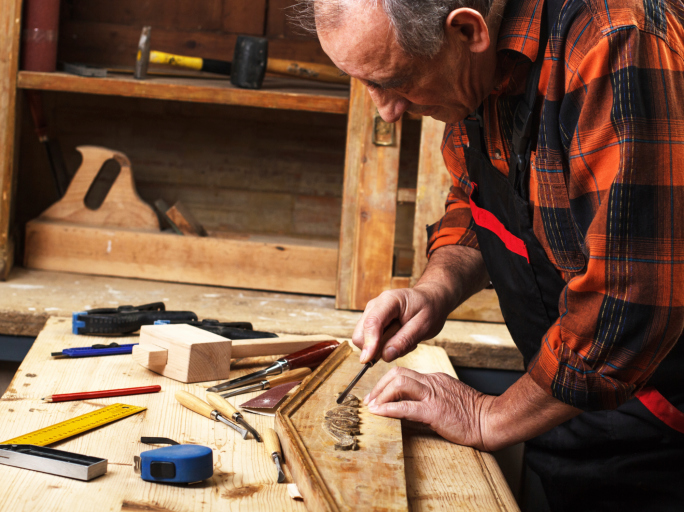Carpentry
Contents |
[edit] Introduction
Carpentry is one of the oldest skilled trades and is still widely required in modern construction. It involves the cutting, shaping and installation of wood (timber) for buildings and other structures.
Carpentry is often part of the ‘first fix' of timber components in the construction of roofs, floors, walls and other timber-framed constructions. It is also often part of ‘second fix' works, such as the construction of skirting boards, architraves, doors, and so on. Carpenters may also required to prepare shuttering (formwork into which concrete is poured), building stairs, installing door and window frames, and so on.
[edit] Types of carpenter
Carpenters often specialise in one or two areas, allowing them to develop and hone their skills accordingly, in particular where they tend to work on larger projects. Some of the different types of carpenter include:
- Rough carpenter: Framing, formwork, roofing and other structural work.
- Joister: Lays floor joists onto which a floor surface is fixed.
- Trim carpenter: Specialises in mouldings and trims, such as mantles, skirting boards), and other ornamental work.
- Cabinet maker: Make cabinets as well as other furniture such as dressers, wardrobes, and so on.
- Ship’s carpenter: Specialise in ship and boat building.
- Framer: Specialise in the framework of buildings.
- Roofer: Specialise in the rafters, beams and trusses of roof construction.
A joiner, or finish carpenter, is typically not considered to be a carpenter (although there is some confusion and overlap between the use of the terms). Joiners generally specialise in lighter and more ornamental work than that done by a carpenter. This includes fine woodworking, fittings, doors and windows, furniture, details, and so on. Joiners typically work in a workshop where the intricate detailing and formation of various joints is made easier by using non-portable machinery. Carpenters on the other hand typically work on construction sites.
[edit] History of carpentry
As timber naturally degrades there are not very many remaining early examples of carpentry. The oldest archaeological finds are water well casings that were built using split oak timbers that were excavated in Germany and date back to circa 5,000 BC.
Some of the world’s oldest wooden buildings are Chinese temples such as the Nanchan Temple which was built in 782, or the stave churches in Norway, such as the Heddal stave church, which were built during the 12th and 13th centuries.
Carpentry evolved over the centuries in line with the technology and tools that were used in construction. Sawmills were widespread by the 16th century, which established the timber industry. The Industrial Revolution of the 18th century introduced steam engines and cut nails, which freed carpenters from the labour-intensive process of relying on handmade nails.
Carpenters largely focused on framed post-and-beam buildings until the end of the 19th century when other materials such as steel and concrete became increasingly popular. There has been something of a resurgence in timber construction recently, with products such as glulam and laminated veneer lumber (LVL) seeking to exploit the sustainable benefits that timber provides.
[edit] Role of a carpenter
The tasks that a carpenter may be involved in might include:
- Interpreting drawings to create an item or component.
- Laying out or designing items or components.
- Determining how to perform tasks efficiently.
- Providing advice about different types of timber and their qualities.
- Cutting or shaping timber using hand or power tools.
- Joining or fixing timber using nails, staples, screws or adhesives.
- Checking accuracy using rulers, levels, plumb bobs, framing squares, and so on.
- Installing items.
- Maintenance and repairs.
Some questions that it can be beneficial to ask a carpenter before hiring them include:
- Do they specialise in a particular kind of carpentry?
- Will any permissions/permits be required?
- Can they work within the wider programme for the project?
- How do they ensure appropriate standards of health and safety?
- How do they ensure appropriate standards of quality?
- What type of timber do they use, and where is it sourced from?
- What sort of storage facilities do they have?
- What steps will they take to ensure deadlines are met?
[edit] Qualifications
Traditionally, a carpenter would train as an apprentice and work their way up to becoming a ‘master carpenter’. On-the-job training is often provided from college or training providers for those seeking to attain the appropriate NVQ/SVQ level. The NVQ/SVQ in Wood Occupations, between levels 1 and 3, is the most common qualification to acquire as a carpenter.
The Institute of Carpenters (IOC) enables carpenters to expand their skills with extra qualifications. Membership of the IOC comes with a bronze, silver or gold card which represents ability.
[edit] Related articles on Designing Buildings
- 11 things you didn’t know about wood.
- Carcass.
- Chip carving.
- Mortise and tenon joints.
- Mortise vs mortice.
- Nails - a brief history.
- Physical Properties of Wood.
- Plumb level.
- The Art of Pyrography.
- Rip sawing.
- Rub joint.
- Sanding.
- Scarf joint.
- The best woods for carving.
- Timber.
- Timber vs wood.
- Tongue and groove joint.
- Tool and equipment care and maintenance.
- Types of skirting board.
- Types of nails.
- Types of timber.
- Veneer.
- Violet Pinwill, woodcarver.
- Waney edged.
- Wood figure.
- Workmanship.







Comments